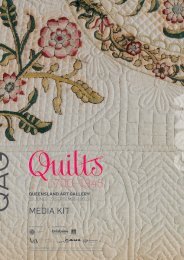Paperskin: barkcloth across the Pacific - Queensland Art Gallery
Paperskin: barkcloth across the Pacific - Queensland Art Gallery
Paperskin: barkcloth across the Pacific - Queensland Art Gallery
Create successful ePaper yourself
Turn your PDF publications into a flip-book with our unique Google optimized e-Paper software.
18<br />
Kavat mask (front and back) 1971<br />
Papua New Guinea<br />
Kairak Baining people, East New<br />
Britain Province<br />
Barkcloth, paper, dye, felt<br />
pen, wood and cane / 135 x<br />
133 x 60cm / Purchased<br />
2009. <strong>Queensland</strong> <strong>Art</strong> <strong>Gallery</strong><br />
Foundation Grant.<br />
croton leaves, was propelled on black legs, pounding in time with <strong>the</strong> drumming,<br />
racing forwards, reversing, <strong>the</strong>n stomping ever closer, <strong>the</strong> head swaying and<br />
pirouetting . . . children screamed in fear and ran to escape. In one last, swift burst<br />
of fervour, <strong>the</strong> masked apparition turned, raced and jumped in to <strong>the</strong> centre of <strong>the</strong><br />
bonfire. There, for a few long seconds it stomped and twisted, burning sticks and<br />
embers scattering in all directions. 17<br />
The baining masks in ‘<strong>Paperskin</strong>’ bear <strong>the</strong> traces of <strong>the</strong>ir performance: soot from fires,<br />
and <strong>the</strong> remnants of dyes and oils used to paint and perfume <strong>the</strong> dancer’s skin.<br />
however, <strong>the</strong>se masks are more than <strong>the</strong>atrical devices: <strong>the</strong>y allow for an interaction<br />
with, and a continuation of, a specific cosmology. living in <strong>the</strong> Gazelle Peninsula in <strong>the</strong><br />
1970s, <strong>the</strong>ologians Karl hesse and Theo Aerts recorded that <strong>the</strong> ‘baining worldview<br />
accepts as it were two worlds, in which <strong>the</strong> o<strong>the</strong>r one (a rimbab) is <strong>the</strong> replica of this<br />
world’. 18 The invisibility of <strong>the</strong> rimbab becomes visible in <strong>the</strong> dances. Masked, <strong>the</strong>ir<br />
bodies adorned with paint and leaves, <strong>the</strong> dancers become <strong>the</strong> manifestation of spirits:<br />
They show <strong>the</strong> forces of nature — but at <strong>the</strong> same time also <strong>the</strong>ir limitations — <strong>the</strong><br />
power of man, and <strong>the</strong> ambiguity of his relationship with that which is constantly<br />
beyond his immediate grasp. 19<br />
in many cultures <strong>across</strong> <strong>the</strong> <strong>Pacific</strong>, <strong>barkcloth</strong> continues to be significant. The<br />
deliberate repetition of geometric patterns has enabled a visual idiom historically linking<br />
<strong>barkcloth</strong> with o<strong>the</strong>r important cultural practices such as tattooing and weaving, as<br />
well as defunct art forms such as rock engravings and lapita pottery. recognition<br />
and appreciation of <strong>the</strong>se designs has ensured <strong>the</strong> art form’s ongoing practice. On<br />
a fibrous surface, using a restricted colour palette and limited combinations of linear<br />
and curvilinear non-figurative designs, <strong>barkcloth</strong> makers have created extraordinarily<br />
diverse works that mediate <strong>the</strong> social and spiritual transformation of both individuals<br />
and groups.<br />
For some, <strong>the</strong> need to sustain this practice — to work communally, and to have goods<br />
to give and exchange — is so strong that, even when lacking <strong>the</strong> essential materials,<br />
<strong>the</strong>y continue to innovate. in <strong>the</strong> mid 1990s in sydney’s west, for example, susana<br />
Kaafi ga<strong>the</strong>red a group of women toge<strong>the</strong>r to cut and glue interfacing material into long<br />
strips. laying <strong>the</strong>m onto a large makeshift table in Kaafi’s backyard, <strong>the</strong>y <strong>the</strong>n painted<br />
<strong>the</strong> strips — using <strong>the</strong> dust scraped from red bricks — with <strong>the</strong> gridded emblems of <strong>the</strong><br />
Tongan monarchy alongside stylised images of <strong>the</strong> sydney Opera house.<br />
Maud Page is Curator, Contemporary <strong>Pacific</strong> <strong>Art</strong>, <strong>Queensland</strong> <strong>Art</strong> <strong>Gallery</strong> / <strong>Gallery</strong> of Modern <strong>Art</strong>.<br />
19

















